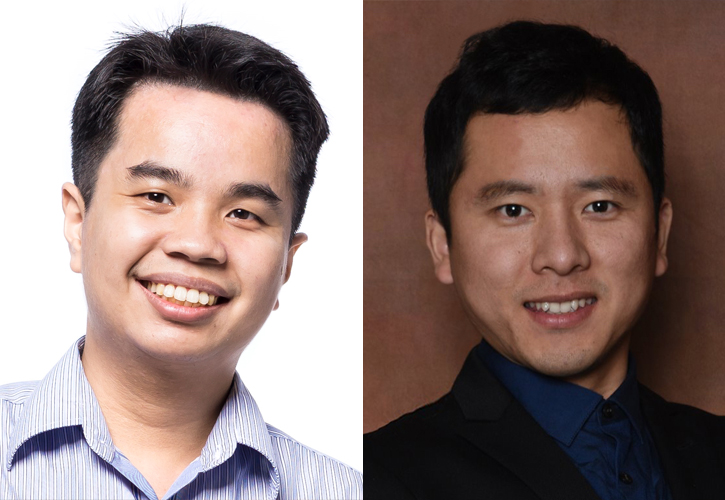Dayton Engineer

Training AI Model to Detect Errors at Earlier Stages in Silicon Crystal Growth
By Dave Larsen
Lam Research Corporation awarded a University of Dayton electro-optics doctoral graduate and a computer scientist $25,000 for fundamental research on artificial intelligence for silicon crystal growth.
Pengfei Guo, who received his doctorate in electro-optics in 2018 under the guidance of Professor Andrew Sarangan, and Tam Nguyen, assistant professor of computer science, received a grant through Lam's Unlock Ideas, which is a university grant program that provides seed funding for research collaborations with professors to support feasibility testing of innovative ideas. The one-year grant runs through August and also supports two master’s degree students, Vatsa Patel and Shashi Adhikari, who are working on the project in Nguyen’s lab.
The research team plans to use artificial intelligence (AI) to improve the Czochralski dislocation-free single crystal growth process for Lam subsidiary Silfex. Headquartered in Eaton, Ohio, about 26 miles west of Dayton, Silfex is the world’s largest custom silicon growing facility.
Using machine learning, they will train their AI model to detect errors at early stages of the growth process. Currently, Silfex relies on human operators to judge the situation and determine solutions, which is costly if the crystal growth run is terminated with zero yields or if the as-grown crystal must be melted down to restart the process.
“If you say, ‘Hey, something wrong happened here,’ it’s late,” Nguyen said. “It’s better to say, ‘Hey, something wrong will be happening in one or two hours.’ Here, we predict the errors that might happen in the near future.”
Guo, a former Silfex process engineer, was the project’s team lead. Under the direction of John Chen, Silfex director of technology, he worked with the Silfex crystal growth team to understand the corresponding process needs and requirements, prepared data and collaborated with Nguyen’s team on how to solve the problem. In September 2020, Guo became a photolithography process development engineer at TDK Headway Technologies near San Francisco.
Manufacturers use silicon to create chips for use in cars, computers, cellphones and other technology. Growing a high-quality crystal silicon ingot is still more of an art than a science, Guo said. It takes years of experience and each test of the crystal is time- and energy-consuming. In some cases, the tests also can be dangerous, involving extremely high temperatures and a large volume of silicon melts in a growth chamber.
His idea for the research collaboration grew out of two of Nguyen’s courses that he took in 2018: deep learning, and advanced programming and data structures. He was impressed by Nguyen’s expertise in these areas, his clear and coherent teaching style, and his ability to explain complex theories in simple language.
“Our research and development team at Silfex, under the direction of John Chen, focuses on implementing disruptive technologies to better serve our semiconductor industry customers,” Guo said. “Leading by the idea of using the deep learning technique to solve the problems in the real world that I obtained from Dr. Nguyen's class, and with support from John, I started to wonder if we could use deep learning techniques to make the silicon growth more controllable and with a higher yield. So, I approached Dr. Nguyen to discuss the feasibility of this task, and we worked on the proposal and won the competition.”
Nguyen’s research focus is computer vision and machine learning. In July 2020, he also was the principal investigator of a project that was awarded $248,338 from the National Science Foundation to use artificial intelligence to monitor motor vehicle traffic in Ho Chi Minh City, Vietnam, and develop a simulation to help urban planners address the city’s traffic and infrastructure problems.
The Silfex project will use data from cameras and sensors that monitor changes at the edge of the crystal to train the AI model. As the AI model learns, it can steadily increase its accuracy for prediction.
“With the successful delivery of this project, we should be able to continuously reduce the silicon material cost, increase our market share and satisfy our customer needs,” Guo said.
The grant also presents an opportunity for Nguyen’s graduate students to follow in Guo’s footsteps. In 2018, 64% of Lam Research’s new college graduate hires in the U.S. were from schools where Lam has academic collaborations or consortia memberships. Some of those job candidates were directly involved in Lam-funded projects or events.
“If the students do well, the company is eager to give the students an internship, and then after their internship the students can begin a full-time job,” Nguyen said. “That is great for the students and good for our University.”
